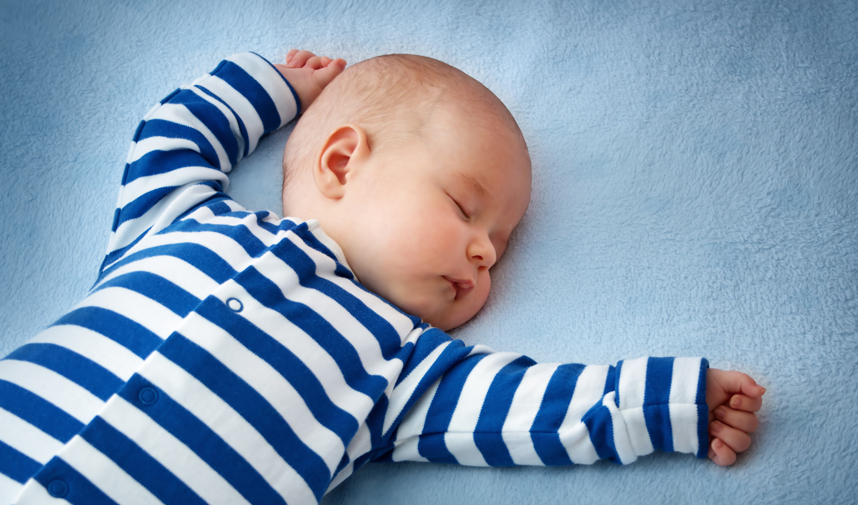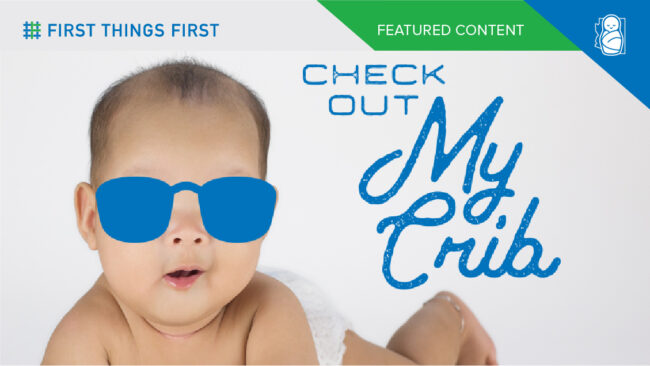Because a good night’s sleep is important for both of you, getting your baby to sleep safely is one of the best ways to protect their health and help them grow. It also gives you peace of mind. You don’t need fancy gadgets or fluffy blankets—just a few simple steps to create a safe, cozy sleep space.

The Safest Way for Babies to Sleep
Always lay your baby on their back for naps and bedtime. It’s the best way to reduce the risk of SIDS (Sudden Infant Death Syndrome), especially during the first year.
Crib Safety
We think that soft, fluffy things nurture and comfort babies, because they comfort us. But soft things like toys and pillows are dangerous in a crib or bassinet. When you are setting up a safe place for your baby to sleep, keep these guidelines in mind:
- Have your baby sleep in a crib or bassinet in your room. Don’t let your baby sleep in your bed.
- Use a firm, tight-fitting mattress with a fitted crib sheet. There should be no space between the mattress and the crib sides.
- Do not put loose blankets, comforters, pillows, bumper pads or stuffed toys in the crib. (An updated law bans crib bumpers as being dangerous.)
- Your baby is in snug sleep clothes (a onesie or sleep sack—no loose blankets)
- Keep all cords away from the crib. This includes cords on curtains and shades, lights, bedding and toys.
- If your baby falls asleep in a car seat or baby carrier, gently move them to their crib or bassinet as soon as you can.
Picking a Safe Crib
- Use a crib that meets current safety standards. If you are using an old crib, make sure it was made after 2011. That is when crib safety standards were improved.
- Check the Consumer Product Safety Commission’s website to see if your crib has a safety hazard. If there is a recall for your crib, the website will provide a contact method for you to reach the company.
- If you need help affording a safe crib, ask your hospital or local health department or contact Cribs for Kids.
- Do not use a crib with a drop rail, decorative cutouts on the headboard or footboard or missing hardware.
- Bars should be no more than 2 3/8 inches apart—a soda can shouldn’t fit between them. Your baby could get their head, hand or foot stuck in the space.
When Your Baby Starts Rolling Over
Once your baby can roll both ways on their own, it’s okay if they end up on their tummy during sleep. But stop swaddling them as soon as they show signs of rolling. Swaddling after this point isn’t safe.
Comfortable, Safe Sleep Clothes
Dress your baby for sleep in close-fitting clothes, like a onesie. Clothes and blankets should not be loose or cover your baby’s face. A sleep sack is like a little sleeping bag with holes for a baby’s head and arms. It is designed to stay away from a baby’s face. If you swaddle your baby, make sure the blanket stays in place.
Safe Sleeping Temperature
If the temperature is comfortable for you, it is the right temperature for your baby, too. Avoid letting your baby get too warm while they sleep, because this increases the risk of SIDS. If your baby is sweating or their chest is hot, they are getting too warm.
Pacifier Safety
Pacifiers can lower the risk of SIDS. If your baby likes one, it’s okay to use it at sleep time. Keep it safe by:
- Using a one-piece pacifier that’s the right size for your baby
- Never tying it to their clothes or crib
- Replacing it when it’s worn out or damaged
Sleep Safety Away From Home
Headed to grandma’s or traveling? Bring a portable crib or bassinet so your baby always has a safe, flat place to sleep. Never let your baby sleep on a couch, chair or bed with adults. These soft surfaces can increase the risk of suffocation.
Smoke-Free Home
Smoke from cigarettes, vapes, candles, incense or fireplaces can raise your baby’s risk of SIDS. A smoke-free home is a safe home. Ask friends and family not to smoke or vape around your baby.


